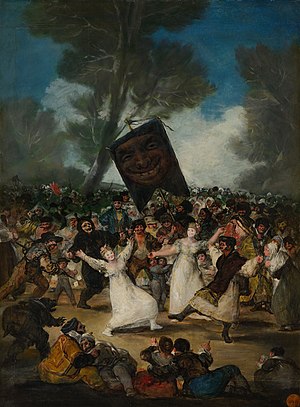You can go along and witness this in Gata de Gorgos on March 5th ( See poster at end of article)
The “Burial of the Sardine” ( Entierro de la Sardina) is a Spanish ceremony celebrating the end of carnival and other festivities. The “Burials” generally consist of a carnival parade that parodies a funeral procession and culminates with the burning of a symbolic figure, usually a representation of a sardine. The “Burial of the Sardine” is normally celebrated on Ash Wednesday but many towns also wait for the weekend after.
But why bury a fish? A little bizarre maybe?
The origins of this tradition of l’Enterrament de la Sardina (the burial of the sardine) are, as with many things, contested, but there are two main schools of thought.
One maintains that it harks back to the reign of Spanish King Carlos III, who, in the 18th century, kindly donated a shipload of sardines to his loyal servants to give them a treat before the start of the 40 days of Lent. Unfortunately the king’s plan went somewhat awry when he discovered the fish had gone off!
Oh dear….. what to do with a whole heap of spoiled and highly pungent seafood? Well, why not bury it in the local park? And this, according to legend, is exactly what happened. Others say that the provenance of the event lies with a group of students who, meeting in a back room of a chemist’s in Madrid in the 19th century, decided to hold a satirical funeral march for the fish symbolising abstinence and fasting.

Huge fiesta in Murcia! 
https://en.wikipedia.org/wiki/The_
Burial_of_the_Sardine Painting by Spanish artist Francisco Goya, usually dated to the 1810s.
Carnival is the festival that marks the last time for mischief, over-indulgence and adds an excuse for a serious party before the purging of vices and the start of some dedicated abstinence during Lent
Ash Wednesday marks the start of Lent and on that day you may see, winding its fiery, raucous way through local streets, a funereal procession featuring a brass band and headed by a huge effigy of a sardine. Once the procession has arrived at its destination, usually the main square of town, a character of upstanding reputation must address the sardine with a satirical “testament de la sardina” (will of the sardine). After all this pomp and ceremony comes the serious business of setting the sardine effigy on fire; this signifies the spiritual cleansing that is fundamental to Lent.
Whatever the origins of this strange and magical event, it is well worth watching and is undoubtedly one of the most fascinating and unusual of the local traditions held during Carnival time.
